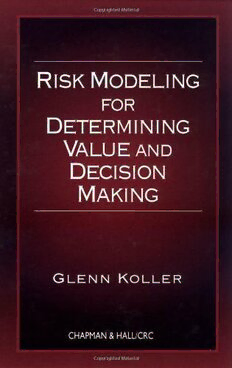Table Of Content~
RISKM ODEL~ING
FOR
DETERMINING
VALUE
AND
DECISION
MAKING
G L E N NK OLLER
CHAPMAN & HALLlCRC
Boca Raton London New York Washington, D.C.
Library of Congress Cataloging-in-PublicationD ata
Koller, Glenn R. (Glenn Robert), 1951-
Risk modeling for determining value and decision making1 by Glenn R. Koller.
p. cm.
Includes index.
ISBN 1-58488-167-4 (alk. paper)
1. Risk assessment-Statistical methods. 2. Decision making-Statistical methods.
3. Value-Statistical methods. I. Title.
HD61 .K633 2000
658.15'5-dc21 00-022387
This book contains information obtained from authentic and highly regarded sources. Reprinted material
is quoted with permission, and sources are indicated. A wide variety of references are listed. Reasonable
efforts have been made to publish reliable data and information, but the author and the publisher cannot
assume responsibility for the validity of all materials or for the consequences of their use.
Neither this book nor any part may be reproduced or transmitted in any form or by any means, electronic
or mechanical, including photocopying, microfilming, and recording, or by any information storage or
retrieval system, without prior permission in writing from the publisher.
The consent of CRC Press LLC does not extend to copying for general distribution, for promotion, for
creating new works, or for resale. Specific permission must be obtained in writing from CRC Press LLC
for such copying.
Direct all inquiries to CRC Press LLC, 2000 N.W. Corporate Blvd., Boca Raton, Florida 33431.
Trademark Notice: Product or corporate names may be trademarks or registered trademarks, and are
used only for identification and explanation, without intent to infringe.
Visit the CRC Press Web site at www.crcpress.com
0 2000 by CRC Press LLC
No claim to original U.S. Government works
International Standard Book Number 1-58488-167-4
Library of Congress Card Number 00-022387
Printed in the United States of America 4 5 6 7 8 9 0
Printed on acid-free paper
About the Author
Glenn R. Koller has responsibility for aspects of risk and uncertainty analysis,
management, and training in BP Amoco (BPA) Corporation. He received his Ph.D.
in geochemistryigeophysics from Syracuse University. Responsibilities of his current
position include implementation of risk-assessment and risk-management technol-
ogies and processes in BPA; development of statistical routines that comprise BPA's
risk systems; keeping abreast of risk technology developed by vendors, other com-
panies, and the National Laboratories; marketing risk technology; and performing
technical and consulting services. Areas of responsibility include business and prod-
uct development, environmental concerns, ranking and prioritization of projects and
products, and other aspects of BPA's diversified business. Dr. Koller currently resides
in Tulsa, Oklahoma. His email address is grk1000@aol.com.
This page intentionally left blank
Acknowledgments
I am grateful beyond measure to Mike A. Long and Phi1 Hammond for their con-
tinued friendship, support, and dedication to our riskluncertainty enterprise. Their
teaching, programming, and customer-relations skills are key elements of our suc-
cessful effort.
I acknowledge and thank Chris Mottershead, BP Amoco's Chief of Staff-Tech-
nology, for his review of this volume and permission to publish. His understanding,
advice, and guidance are truly appreciated.
I thank Roger Rowe for his encouragement and friendship. I look forward to
working with Roger on future projects.
I express my deepest appreciation to my wife Karen, my daughters Stephanie
and Kathy, and my son Matthew. Writing a book is an exceedingly time-consuming
undertaking. Every hour spent on the book-writing effort is an hour not spent with
the family. I truly appreciate their love, patience, and understanding.
This page intentionally left blank
To Karen, Stephanie, Kathy, and Matthew -
my reasons for living.
Thank you for your love, patience, and understanding.
This page intentionally left blank
Contents
Introduction .............................................................................................................. 1
Scope .......................................................................................................................... 1
Realism ...................................................................................................................... 2
Models. Validation. and Precision ............................................................................. 3
Value .......................................................................................................................... 4
EXAM PI! ES
Chapter 1
Two Approaches to Solving Decision Trees .
A Class-Action-Suit Example ........................................................................ 7
Introduction ................................................................................................................ 7
Building the Decision Tree ........................................................................................ 9
What Is the Question? ............................................................................................. 14
Interpretation of the Probabilistic-Branching Model .............................................. 19
So. So What? ........................................................................................................... 20
Chapter 2
Terrorism Risk Models Relative and Absolute Risk .................................... 21
--
Terrorism Relative-Risk Model ............................................................................... 21
What Is the Question? ............................................................................................. 22
Building the Contributing-Factor Diagram for the Relative-Ranking
Terrorist-Threat Risk Model ........................................................................... 23
Category Weights ..................................................................................................... 27
Relative-Risk Model Equations ............................................................................... 28
Relative-Risk Model Applied to Terrorist Organization #l .................................... 29
Relative-Risk Model Results from Evaluation of Terrorist Organization #l ......... 37
Relative-Risk Model Applied to Terrorist Organization #2 .................................... 39
Relative-Risk Model Results from Evaluation of Terrorist Organization #2 ......... 48
Comparison of the Two Terrorist Organizations ..................................................... 49
Building the Terrorism Absolute-Cost Risk Model ................................................ 53
Absolute-Cost Risk Model Equations ..................................................................... 55
Application of the Absolute-Cost Risk Model to Terrorist Organization #2 ......... 55
Absolute-Cost Risk Model Results for Evaluation of Terrorist
Organization #2 ..............................................................................................6 1
So. So What? ......................................................................................................6..2.. .

